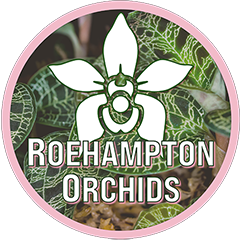Can I use Ice Cubes to water my Orchids?

Author: Diane Özdamar
For more resources please join us at Canadian Orchid Growers
We want to talk a little about watering habits for orchids. If you have bought Phalaenopsis orchids in grocery stores or in flower shops, chances are you may have come across the infamous « add three ice cubes weekly to water » marketing advice.
Using ice to water is extremely polarizing in the orchid community due to the fact in some circumstances it has caused growers to lose their plants. The use ice methodology should prevent overwatering right? Well it’s a little more complicated than that.
We hope you find this piece useful and we will provide some basic care tips for beginners. Ultimately as a hobbyist you will be responsible for making your own decisions on how you grow and which watering method you want to use in the end.
Firstly, Phalaenopsis orchids are tropical plants and rarely experience cold temperatures in situ (the wild). They are fairly temperate tolerant and some cooler deciduous species can tolerate temperatures of 12°C / 54°F. It is however usually not recommended go below 18°C / 64°F. This is especially important for summer blooming Phalaenopsis from the Polychilos subgenus as they are much more sensitive to cold temperatures than the typical store purchased NOID Phal.
The perceived issue of watering with ice is this that the cold water melting onto the roots may cause damage. This may set back the orchid in the long run, despite the fact it may not immediately show. I would like to point out that there is no research of evidence that says this is true, but merely years of growers saying it’s not advised. Moreover, the layering of various media could warm the water to room temperature. Again, very little evidence or research done on this topic.
Root concerns are especially hard to detect since lack of visibility due to media covering the roots, or solid pot colour. As a side note, companies that sell orchids along with the « just add ice cubes » advice typically do not attach any care sheet. This can lead to questions or lack there of on the growers side.
Growers should also consider the quality and type of substrate and of pot type/size. If the orchid is potted in a well-aerated medium, and the pot has multiple ventilation slits both at the bottom and on the sides, your orchid will always be breathing and dry out in appropriate time.
In terms of potting medium, there are several tiles available to use:
Bark
Sphagnum moss
Leca
Seramis
Horticultural charcoal
Coconut husk or coir
Tree fern
Hygrolon
Perlite
Pumice
In addition mounts and pot types include:
Cork bark mount
Ceramic mount
Plastic pots
Ceramic pots
The aforementioned media and pots/mounts all work great and can vary between growers based on climate and preference. For instance, in a very dry and warm climate, using a good portion of sphagnum moss or a semi-hydro setup (another polarizing topic) would be better than mounting your orchid or using plain chunks of bark, as the highly water-retentive sphagnum moss helps reduce the watering schedule frequency.
In a colder and more humid environment, using bark or mounting your orchids would be preferable: water cannot evaporate as fast as it would in a dryer climate and could lead to root rot and pathogen issues, a less water-retentive medium is thus more suitable.
Moreover, to ensure you are not overwatering, only water when you see that the medium is approaching dryness. With Phalaenopsis, this is evident when the roots are turning to a silvery color instead of bright green. Use room temperature. Allowing the water to sit over night results in lower levels of chlorine.
There are two common watering techniques: you can either fill a container and let the whole pot soak for 20 to 30 minutes then drain, or top water through the pot for a 10-15 seconds until the whole substrate is wet. Using ice cubes is a good way of measuring volume of water so as to not over water but the main concern is cold water in the root zone.
Ensure water PH is not too alkaline. Most Phalaenopsis orchids (except for a few species that live on limestone) actually enjoy slightly acidic water better than alkaline water. Rain water being slightly acidic, orchids have evolved to better absorb nutrients at specific PH levels, the optimal PH levels ranging from PH 5.5 to PH 6.5
We hope you liked our short tutorial and we welcome comments and feedback with your watering techniques whether using ice or not.
Your orchids will thank you!
(and big thanks to Andrew Geimar for proof-reading, giving great advice and feedback, this tutorial would have been way messier without his intervention ![]() )
)
